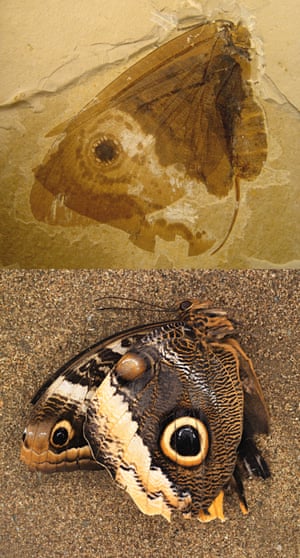Originally published at Lost Worlds Revisited for the Guardian Science Blog Network on 4 March 2016:
https://www.theguardian.com/science/2016/mar/04/which-came-first-the-butterfly-or-the-flower-lacewing-oreogramma-bennetite-fossil
New discovery of a butterfly ‘mimic’ predates them by 40 million years.
Lacewings (Neuroptera) are common insects in UK gardens. They can be recognised by their four transparent wings, which bear a lace-like network of veins and which gives them their name. This group of insects has a long and worthy fossil record, starting back in the Permian period, 250 million years ago. Most people are familiar with the idea of insects trapped in amber (thank you, Jurassic Park), and fossils preserved in this way are often spectacular, but many insect fossils are preserved in a more conventional, and less glamorous, mode: compression fossils sandwiched between layers of fine-grained sedimentary rock. Kalligrammatid lacewings are an extinct group known exclusively from this type of preservation, from the Middle Jurassic (about 160 million years ago) until the Early Cretaceous (about 120 million years ago), and their fossils have been discovered from across the world.
Kalligrammatid lacewings are interesting because they are a classic example of convergent evolution. They closely resemble butterflies (Lepidoptera), which do not appear in the fossil record until around 56 million years ago. Molecular studies suggest an earlier origin for butterflies, around 80 million years ago, but this still represents a clear 40 million year gap between the two insect groups. A recent paper by Conrad Labandeira and colleagues demonstrated that the convergence seen between kalligrammatid lacewings and modern butterflies was more than a superficial similarity.
Details of kalligrammatid wing eyespots and their pigmentation, their wing scales, and their evolution of a long proboscis for siphoning nectar all bore close comparison with examples from the modern Lepidoptera. Both types of insect were making their living in a spookily similar way, despite enormous changes in the plant groups providing their habitat and diet during the Mesozoic Era.

The flowering plants, or angiosperms, are the dominant plants on Earth today. They provide the vast majority of the plant-based food we eat (unless you are a really big fan of either pesto or nori). Farmers, scientists and policy-makers all worry a great deal about how they are pollinated, and the about the health of key insect pollinator populations, especially bees. The future of insect-pollinated angiosperms and their pollinators are inextricably linked because they have evolved together in tight evolutionary feedback loops (an example of coevolution). Butterflies evolved alongside the angiosperms, as they diversified into the 350, 000 flowering plant species we see today – but unequivocal angiosperm fossils (pollen and whole organs) are only known from around 130 million years ago onwards, too late for coevolution with the kalligrammatid lacewings. So what plants were the kalligrammatids coevolving with?
If you look at the illustrations in children’s dinosaur books, it won’t take you too long to come across a plant in the background, looking something like a large, squat pineapple covered with flowers. These are bennettites, an extinct group of seed plants with a superficial similarity to cycads (another ancient, but surviving, group of seed plants). They have very different reproductive structures to cycads though, and these have been interpreted by many researchers as ‘flower-like’ in their organisation and complexity.
Over the last century or so, the relationship between angiosperms, bennettites and other seed plants such as the gnetophytes (species including Ephedra) has been fiercely debated. Molecular sequence-based methods can only go some way to untangling their family tree, since the bennettites became extinct about 65 million years ago, and DNA that old has never been retrieved (thanks again, Jurassic Park). Whatever the relationship between early angiosperms and bennettites, in terms of ecology, bennettites are the likely suspects in any early partnerships between ‘flower-like-organs’ and insect pollinators.
Close associations between bennettites and boring beetles (the sort who make holes, rather than the merely dull) have been described in Cycadeoidea, a type of bennettite in which the pollen-bearing ‘flowers’ appear to have remained embedded within the trunk of the plant throughout the life-cycle of the plant. Were tunnelling, pollen-eating beetles therefore essential to its pollination? Similarly, Labandeira and colleagues propose that the elaborate siphoning mouthparts of some kalligrammatid lacewings evolved to exactly complement another group of bennettites.
Members of the Williamsoniaceae family bore their flower-like organs externally on stalks, rather than packed inside their trunk, and the long, sturdy mouthparts of some kalligrammatids would be ideally suited to probing their female flower-like organs for, presumably, nectar-like fluid. This reading of the fossil record suggests that plant-animal coevolution can result in staggeringly similar results from similar ecological interactions, even when the plant and animal groups involved are only distantly related, and separated by many millions of years.
With coevolution comes mutual interdependence, right up to the bitter end. The sudden radiation of the angiosperms during the Cretaceous was matched by a sharp decline in previously dominant seed plant groups, including the bennettites. The kalligrammatid lacewings also drop out of the fossil record by the mid Cretaceous. We would do well to keep a very watchful eye on our modern crop-pollinating insect friends.
